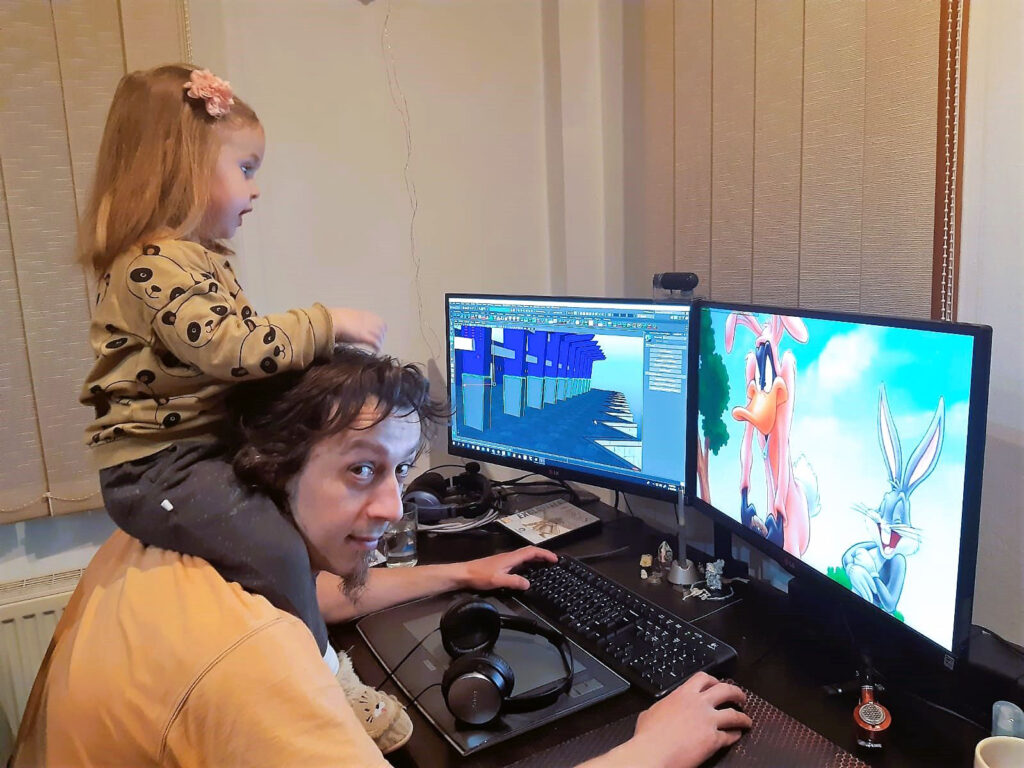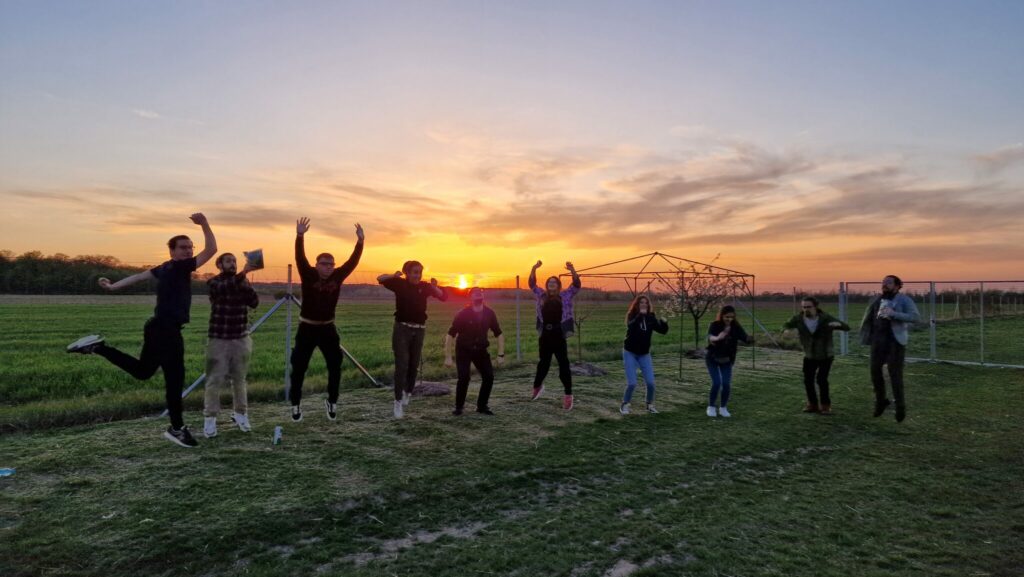A while back, our perception of working remotely in gamedev was almost synonymous with freelancing, reserved for the adventurous, the indies, the nomads, the restless developers. They get tired of working on the same project for long periods and turn to freelance as a way of life. Work as you need, take vacations when you want them, you can always work later or when you need to top off your bank account. Stay in your jammies all day if you feel like it, go to your shared office space (a different one every month!), rent a house in the countryside or move to another town altogether. Shift your schedule as you please, get it done by the deadline and be your boss.

And all of these as opposed to those working at the office, as part of a more established ecosystem, where we routinely gather in the same physical space and share our efforts/ideas/hardships/laughs/successes and sometimes our food. In this case, the schedule is a bit more rigid, with well-established working times and – for better or worse – the daily commute to this place of buzzing intellectual activity.
Because both sides have their PROs and CONs (which we won’t get into more than I already have, worry not), we concluded that you have to take a good look at yourself, what type of collaboration you like, what environment you thrive in, pick a winner and run with it till your pension. At that time, there wasn’t a best of both worlds scenario.
But in the last few years (which is a short time, by the way), we’ve been experiencing a revolution in how we think of working. With the advent of Covid-19, we all had to deal with personal tragedy, global restrictions, and other changes that affected our way of living significantly. The most profoundly impacting of which (statistically, by the number of people affected) was blurring the line between working alone remotely and working together in the exact physical location.
The office environment suddenly migrated into the digital space. Thus we all had to get webcams, headsets and mics, reorganise our living room, share the same area with our kids & pets instead of our colleagues, and adapt in a short amount of time so we could be productive. Being surrounded by like-minded people and innovative materials that get you in the flow is key to our success, mainly if you aim for innovation.

Now you have to accommodate the kid who AGAIN can’t find his favourite shirt and stepped on the cat, your partner who is having “that team meeting” again next door (if you’re lucky) and the neighbours who are renovating during your brainstorm session. Add to this the increase in energy bills (since you’re running the workstation 8-9 hours straight), lesser social interaction and emotional connection (we all crave connection, right?), less exercise since there is no commute; the gut-wrenching feeling of seeing your workstation as soon as you get up in the morning (especially during a less than ideal project period), a somewhat dip in hygiene routine since “Hey! No one’s smelling me today right? I can forego my shower”. It’s … challenging.
Even though the health crisis has calmed down now, some companies discovered they don’t need an office space and have shifted to online/remote only. Other companies recalled their employees back, only to have some expressing the need for a work-from-home employment option, quoting their productivity scores on par with the ones before work restrictions were imposed. For some businesses, WFH migration is more accessible to implement than others, but even in those cases, let’s be honest, there are challenges regarding data security, equipment maintenance, employee benefits and so on.

Here at AMC, we took up the challenge of empowering those who wish to switch to remote work. So some of us decided to take the leap, not only to apply for WFH but even to move out of the crowded capital city. Some of us have been dealing with trying to stay focused, avoiding burnout, respecting the work-life balance, exercising enough, eating cooked food instead of ordering, setting boundaries in “my office”, and keeping in touch with our colleagues beyond our planned meetings.
We formulated some guidelines for ourselves that will hopefully help others adjust to this new work style if they find themselves struggling. Here are our SIX TIPS for an efficient wfh:
1. Set up a (flexible) routine and keep to it.
Include in it a getting up schedule, working out, eating, sleeping and doing stuff other than work. This way, you’re mimicking a plan that your on-site job imposed naturally. Get up and stretch at regular intervals. Apart from the fact that it’s healthy, you’re replicating getting up from your desk and touring the office. The pause relaxes your brain and gives you something else to look at other than bright screens.
2. Ensure your hardware and software are top-notch.
So that you get a seamless experience when getting together in online meetings. Nothing is more bothersome and brings the physical distance into the foreground than choppy transmission, muffled audio, ambient noise, and someone else’s meeting acoustically permeating into yours for all other participants to enjoy. Having a Gigabit connection, good quality microphone and a high-quality camera – all tested beforehand – can prevent any meeting from resembling a spiritual summoning of the departed: Are you there, Helen? Can you hear us? Give us a sign if our words can reach you!

Use an excellent quality work system: camera and headphones, with great passive noise cancelling (active if you don’t mind the “whoosh” and dip in sound quality). This helps drown out the chatter someone else is having next door from you, in the absence of actual meeting rooms like in the office. Andrei, our tech artist, went one extra step and got a pair of noise reduction headsets used on quarries and construction sites. 😊 Because sometimes he needs to focus without any other sound, not even music.
Ensure your workstation, company-supplied hardware, and Internet connection have the same working conditions and specs as back in the office, or at least very close. If the employer enables this option for their team, then a specific responsibility comes with it. Ensure all the proper working conditions are met and that your hardware is protected by power surges and data losses, just like in the office.
3. Set clear boundaries.
Make sure nobody can disrupt your workflow (for menial things, of course, fire breaking loose is an obvious exception). In the office, we have FocusTime™ or DoNotDistrub™ (we use antler headbands in the office when we don’t want to be disturbed), so it makes sense we should adapt it at home to ensure undisturbed concentration when needed.
If possible, separate your desk clearly at home and have your workstation in a different room/location than where you usually hang out at home.
Andrei’s suggestion: I don’t have a big apartment, so that option is off-limits. Instead, I created a set of “triggers” that signal the fact that I’ve stopped working and now it’s “me-time”. Apart from switching to my personal PC, I swapped my mouse to a different one, shut off one of the monitors and placed my microphone to the side. It may not sound like much (even silly, but hey, I hope you appreciate my honesty), but it helps to draw the line between the two states – me at work and me at home.

When you say you’re off-duty, mean it! Don’t just put the workstation in sleep mode; easily accessible at the flick of the mouse to see what’s going on in the project chatrooms or if some critical email has arrived (that can totally wait for tomorrow, btw). It will prevent burnout and prevent a backdoor towards work in your personal life. You also show respect and consideration for your family members, who expect to have your full attention, just like when you came back from the office.
4. Make room for levelling up.
We all have big dreams and goals and want to make them come true. To achieve those goals, you must become better, learn new skills and take new chances. Working from home can sometimes prevent us from keeping our growing paths straight. So be prepared and keep learning.
5. Find your tribe in your community.
We are social animals. We crave connection. Keep in touch with teammates outside project-related stuff. More specifically, the usual banter and joking that happened during working hours and made being in the office more enjoyable. For this, we use Discord and have channels designated as Work & Talk, chatrooms for industry-themed memes or simply impromptu Voice & Video gatherings. Ensure you carefully select the right time to engage these channels so they don’t become distractions and impede your productivity. If possible, get together in person from time to time. It also disciplines you to groom yourself for the occasion, which is a highly overlooked aspect in the age of filters. 😁 AMC proactively engages this point by organizing regular events at the office, parks, theatres, cinemas and beer gardens. By reconnecting in a shared space once in a while – despite the physical distance – you get back some feeling of being part of the pack, regardless of where your actual workstation is.

6. Make sure to take care of the most critical asset in the equation: YOURSELF.
Last, but definitely not least. Your rest is at least as important as your work.
This list is by no means exhaustive nor applicable to everyone or every situation.
We hope that you’ll find at least one point that helps you better enjoy the flexibility that #wfh offers.
We also know that each approach (#wfh or at the office) comes with benefits and downfalls, so let’s just be open and tolerant to each option.
Enjoy the ride and take the best from each of them!
Any feedback and suggestions on improving productivity and life would be much appreciated.
Thanks so much, Andrei Danescu, for your significant contribution to this article! ❤

